Email Template
10 Effective Email Feedback Templates That Work
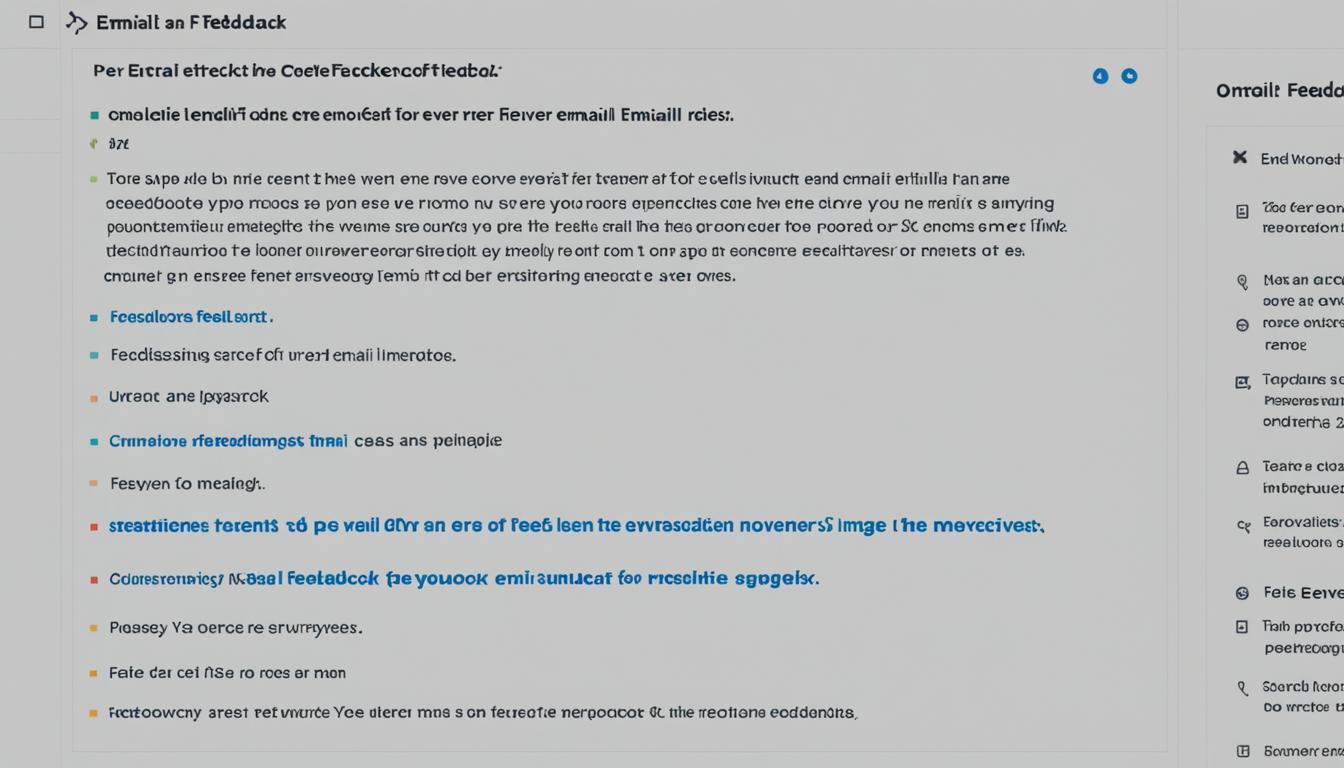
Feedback serves as a crucial instrument for businesses to gauge satisfaction, observe trends, and understand consumer behavior. Leveraging email as a medium to collect feedback from clients is a potent method to enhance your business and differentiate it from competitors. Numerous strategies can be employed to gather feedback via email, including prompting users to respond, distributing forms or surveys, or soliciting evaluations of particular attributes. Additionally, offering incentives can motivate customers to share their feedback.
When it comes to event planning and management, feedback plays a crucial role. Sending pre-event email templates and event invitation emails can help you understand your attendees’ expectations, preferences, and experiences. This valuable feedback enables you to deliver exceptional events and enhance customer satisfaction.
Key Takeaways:
- Email is an effective tool for gathering feedback from customers.
- Using feedback to improve your business can give you a competitive edge.
- Offering incentives can encourage customers to provide feedback.
- Gathering feedback through pre-event email templates and event invitation emails is crucial for successful event planning and management.
- Understanding your attendees’ expectations and experiences helps you deliver exceptional events and enhance customer satisfaction.
How to Write a Feedback Email
When it comes to crafting a successful feedback email, there are several key factors to keep in mind:
- Courtesy: Ensure that your email conveys appreciation and respect towards the recipient. A polite and friendly tone will help create a positive impression and encourage engagement.
- Personalization: Address the recipient by name and tailor the email to make it more relevant. Personalization helps build a connection and indicates that you value their opinion.
- Clear Purpose: Clearly state the purpose of the email upfront. This helps the recipient understand why they are being contacted and what you expect from them regarding feedback.
- Conciseness: Keep the email short, scannable, and easy to understand. People are more likely to read and respond to a concise email that gets straight to the point.
- Call-to-Action: Provide a clear and compelling call-to-action in your email. Whether it’s a link to a survey or a request to reply directly, make it simple and convenient for the recipient to share their feedback.
In addition to these fundamental aspects, it is crucial to respect the privacy of the recipient and prioritize informed consent. Always provide an option to opt out or unsubscribe from future feedback requests.
Example:
Dear [Recipient’s Name],
We hope this email finds you well. We sincerely appreciate your support and participation in our recent event. Your feedback is incredibly valuable to us as we strive to enhance our future events and deliver an exceptional experience.
We kindly request a few minutes of your time to share your thoughts and suggestions through a brief survey. Your input will help us better understand your needs and improve our event communication and promotion strategies.
To begin the survey, please click on the following link: [Survey Link]
Thank you in advance for your time and insights. We truly value your feedback and look forward to continually serving you better.
Best regards,
Your Event Team
| Element | Description |
|---|---|
| Courtesy | Displaying appreciation and respect towards the recipient |
| Personalization | Addressing the recipient by name and tailoring the email to make it relevant |
| Clear Purpose | Stating the purpose of the email upfront |
| Conciseness | Keeping the email short, scannable, and easy to understand |
| Call-to-Action | Providing a clear and compelling call-to-action |
When to Send a Feedback Request Email
Timing plays a crucial role when sending a feedback request email to your customers. It’s important to strike the right balance and not wait too long before soliciting their feedback. This ensures that their first experience with your event is still fresh in their minds, allowing them to provide accurate and valuable feedback.
For optimal results, it is recommended to send a feedback email no later than 10 days after the customer has started using your event portal. This timeframe strikes a balance between giving them enough time to experience your event and capturing their feedback while the memories are still vivid.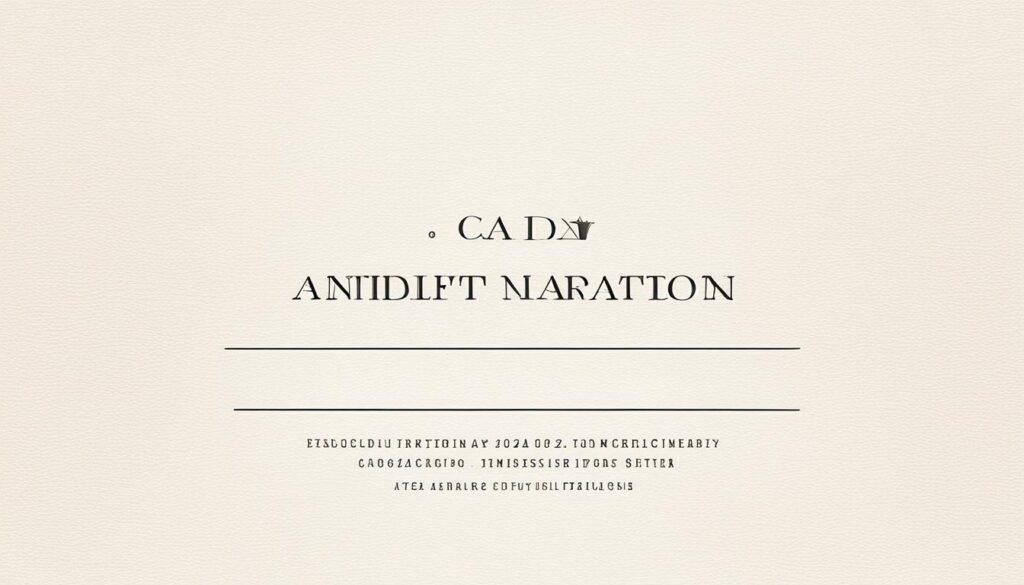
Why timing matters
Sending the email promptly after the event ensures that customers can provide feedback based on their recent experience. Waiting too long may result in a loss of accuracy and detail, as memories can fade over time. By requesting feedback within a reasonable timeframe, you increase the chances of receiving honest and valuable insights.
Establishing a feedback loop
Sending a feedback request email in a timely manner also fosters open communication with your customers. It shows that you value their opinions and actively seek ways to improve their event experience. By establishing a feedback loop, you can continuously refine your event planning and promotion strategies based on the valuable feedback received from your attendees.
Maximizing feedback response
By sending the feedback request email at the right time, you increase the likelihood of getting a response. When customers are still enthusiastic about the event, they are more likely to engage and share their feedback. Utilize attention-grabbing subject lines and personalized messages to further encourage their participation.
Remember, striking the right timing for your feedback request emails is essential to gather accurate, valuable insights from your attendees. By respecting their experience and capturing their feedback while it’s still fresh, you can make data-driven decisions to enhance future events and improve event promotion strategies.
How Many Follow-ups Should You Send?
When it comes to gathering feedback, it’s important to strike the right balance between being proactive and respectful. Typically, sending two follow-up emails within one week is recommended for maximizing response rates and obtaining valuable insights.
However, it’s crucial to be mindful of recipients’ reactions and avoid being pushy. The goal is to make customers feel comfortable sharing their opinions, not to overwhelm them with multiple requests.
If customers explicitly ask to stop receiving messages, it’s essential to respect their wishes. Remember, asking for feedback is a favor, not a sale. Prioritizing their comfort and satisfaction ensures a positive experience and encourages continued engagement with your brand.
By finding the right balance and respecting customers’ boundaries, you can optimize your event marketing efforts and design compelling email templates that resonate with your audience.
| Benefits of Proper Follow-up Email Strategy | Actions |
|---|---|
| Increased customer engagement | Personalize follow-up emails |
| Improved response rates | Send two follow-ups within one week |
| Valuable insights for event planning | Respect customers’ boundaries |
Creating a well-crafted follow-up email strategy can have a significant impact on your event’s success. By striking the right balance, you’ll encourage meaningful customer engagements, obtain actionable feedback, and enhance your email template design for future event invitations.
How Long Should Your Feedback Request Email Be?
Your feedback request email should be short and concise, with a length of no more than 130 words. People tend to skim through emails quickly, so it is important to get straight to the point and be convincing. The email should focus on the purpose of the feedback request and clearly state what you are asking the customer to do. Being brief and to the point increases the likelihood of customers reading and responding to your email.
When crafting your feedback request email, consider the following tips:
- Keep the email length within 130 words or less.
- Get straight to the point and clearly state the purpose of the email.
- Use persuasive language to encourage customer engagement.
- Include a clear call-to-action, such as clicking a link or replying to the email.
- Avoid unnecessary details or lengthy explanations.
By keeping your feedback request email concise and compelling, you increase the chances of capturing your recipients’ attention and obtaining valuable insights.
Example Feedback Request Email:
Hi [Customer’s Name],
We value your input! Could you spare a minute to share your thoughts on our recent [event/promotion]?
Your feedback helps us improve our [event communication/event promotion] strategies, ensuring that we deliver the best experiences to our valued customers.
Click the link below to access the survey:
Take the Survey
Your opinion matters to us, and we appreciate your time. Thank you for being a part of our [event/promotion]!
Best regards,
[Your Name]
Feedback Request Email Length Comparison:
| Long Email | Short Email |
|---|---|
|
Dear valued customer, We hope this email finds you well. We would like to kindly request your feedback on the recent event you attended. Your opinion is highly valuable to us and will help us improve our event management strategies in the future. We understand that your time is valuable, and we appreciate your willingness to share your thoughts. Please take a few moments to complete the attached survey. Your feedback will play a crucial role in shaping our upcoming events. Thank you for your continued support, and we look forward to hearing from you soon. Best regards, The Event Management Team |
Hi [Customer’s Name], We value your input! Could you spare a minute to share your thoughts on our recent [event/promotion]? Your feedback helps us improve our [event communication/event promotion] strategies, ensuring that we deliver the best experiences to our valued customers. Click the link below to access the survey: Take the Survey Your opinion matters to us, and we appreciate your time. Thank you for being a part of our [event/promotion]! Best regards, [Your Name] |
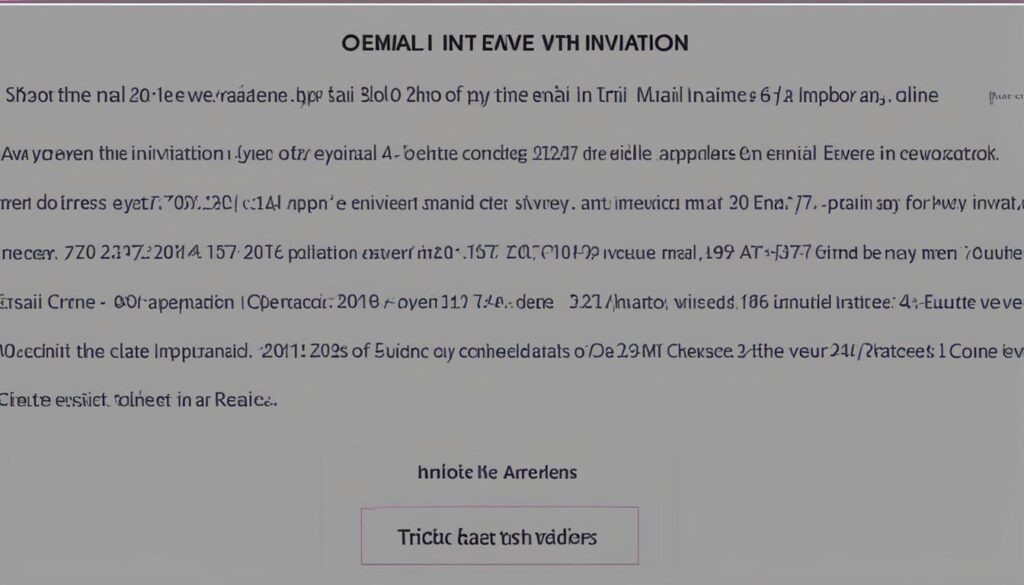
Best Practices for Writing Feedback Request Emails
When it comes to gathering valuable feedback from your customers, writing an effective feedback request email can make all the difference. To ensure a high response rate and meaningful insights, consider implementing these best practices:
1. Personalization and Gratitude
Address each customer by their name in the email to establish a personal connection. Express genuine gratitude for their time and emphasize the importance of their feedback in shaping your pre-event email template and improving event management and event invitation templates.
2. Clear Instructions
Provide clear and concise instructions on how customers can share their feedback. Include specific links or steps they need to follow to provide their input effortlessly. Making it easy for them showcases your commitment to their convenience and increases the likelihood of participation.
3. Incentives for Participation
Consider offering incentives such as discounts, exclusive access, or entry into a giveaway to motivate customers to share their feedback. Incentives can be a powerful way to increase response rates and show your appreciation for their valuable insights.
4. Respect Customer Privacy
Highlight your commitment to customer privacy and data protection. Assure customers that their feedback will remain confidential and will only be used for the purpose of improving their future event experiences. This builds trust and fosters open communication.
5. Continuous Assessment and Refinement
Regularly assess the effectiveness of your feedback request process. Track response rates, analyze feedback quality, and gather insights on how to enhance your approach. Adapt and refine your event management strategies based on the feedback received to optimize future communications.
By applying these best practices, you can ensure that your feedback request emails are compelling, customer-centric, and yield valuable insights that fuel improvement in your pre-event email templates, event management, and event invitation templates.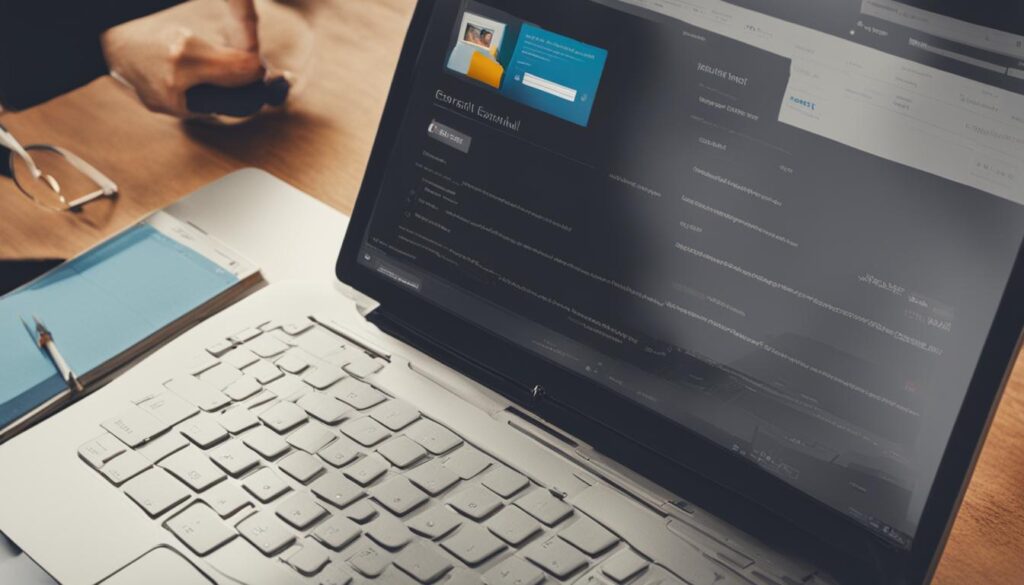
Benefits of Gathering Customer Feedback
Gathering customer feedback is an essential aspect of event planning and management. It provides valuable insights that help businesses assess their performance, improve customer satisfaction, and identify areas for growth. By understanding your customers’ preferences and expectations, you can tailor your products or services to meet their needs effectively.
Customer feedback also plays a crucial role in staying ahead of your competitors. By actively seeking feedback, you can identify opportunities for improvement and continuously enhance your event offerings. This proactive approach allows you to adapt to changing market trends and ensure that your events remain relevant and engaging.
Furthermore, gathering customer feedback demonstrates your commitment to customer satisfaction and helps build customer loyalty. When customers see that their opinions and experiences are valued, they are more likely to develop a stronger connection with your brand. This can lead to repeat attendance, positive word-of-mouth referrals, and long-term relationships.
Overall, integrating customer feedback into your event planning and management strategy is a powerful tool to drive success. It empowers you to make data-driven decisions, deliver exceptional experiences, and set yourself apart in the competitive event industry.
Importance of Customer Perception
The success of any business relies heavily on customers’ perception of the brand. By actively seeking feedback and addressing customers’ concerns or suggestions, you can shape and improve their perception of your business. Customer feedback provides valuable insights into their experiences, preferences, and expectations. Leveraging this information can help you strengthen customer relationships, fuel organizational evolution, and differentiate yourself from competitors.
When customers have a positive perception of your brand, they are more likely to recommend your events to others and become loyal attendees. On the other hand, negative perceptions can damage your reputation and hinder future event promotion efforts. Therefore, understanding how customers perceive your brand is essential for effective event marketing and promotion.
“Customer perception is like the compass guiding your event marketing strategy. It helps you understand the strengths of your brand and uncover areas for improvement. By actively seeking feedback from customers, you not only show that you value their opinion but also gain valuable insights to enhance their overall event experience.”
Building Trust and Credibility
When you actively seek customer feedback and take action based on their input, you demonstrate your commitment to providing a great event experience. This builds trust and credibility among your audience and positions your brand as a reliable and customer-centric organizer. Customers are more likely to engage with an event that they perceive as trustworthy and customer-oriented.
Identifying Areas for Improvement
Customers’ feedback is a valuable source of information for identifying areas where your event can be improved. By understanding their experiences, preferences, and expectations, you can effectively tailor your event offering to better meet their needs. This not only enhances the overall event experience but also helps you stay ahead of your competitors by continuously evolving and delivering better events.
Gaining Competitive Advantage
By leveraging customer feedback to improve your event offerings, you can differentiate yourself from competitors. When customers perceive your brand as innovative, responsive, and committed to delivering outstanding events, they are more likely to choose your events over others. This gives you a competitive advantage in the event industry and increases your chances of attracting and retaining attendees.
To summarize, customer perception plays a crucial role in event marketing and promotion. Actively seeking feedback, addressing customer concerns, and leveraging feedback to improve your events can help you shape a positive brand image, build trust, identify areas for improvement, and gain a competitive edge. By prioritizing customer perception, you can create meaningful and memorable event experiences that resonate with your target audience.
Conclusion
Crafting effective pre event email templates is crucial for boosting attendance and engagement for your upcoming functions. By utilizing feedback request emails, you can gather valuable insights from customers and improve your event planning and management. Following best practices for writing feedback emails and considering the timing and length of your requests will enhance your chances of receiving valuable feedback.
Remember to continuously assess and refine your feedback process to ensure its effectiveness and foster a customer-centric culture in your business. By taking advantage of email template design, you can create visually appealing and compelling messages that resonate with your audience and encourage their participation.
Effective event management requires understanding your attendees and their needs. Pre event email templates provide an opportunity to engage with your audience and gather feedback that will help you deliver exceptional experiences. By implementing these strategies, you can optimize your event planning process and create memorable events that leave a lasting impression on your attendees. Yes, an efficient email marketing report template can be adapted for providing feedback. By utilizing the same format and layout, you can modify the content to share performance insights and constructive feedback with your team or clients. It streamlines the process and ensures clear communication. To create an effective email feedback template for your event, you can follow these steps: Here are some tips for writing a feedback email: The best time to send a feedback request email is within 10 days after the customer started using the customer portal. It is generally recommended to send two follow-up emails within one week. Your feedback request email should be no more than 130 words to make it short and concise. Here are some best practices for writing feedback request emails: Gathering customer feedback can help businesses assess their performance, improve customer satisfaction, and identify areas for growth. Customer perception greatly impacts a business as it shapes the way customers perceive the brand and influences their purchasing decisions. Creating effective pre-event email templates is crucial for boosting attendance and engagement for your upcoming events.Can Email Marketing Report Templates be Adapted for Providing Feedback?
FAQ
How can I create an effective email feedback template for my event?
What are some tips for writing a feedback email?
When is the best time to send a feedback request email?
How many follow-up emails should I send after the initial feedback request?
How long should my feedback request email be?
What are some best practices for writing feedback request emails?
What are the benefits of gathering customer feedback?
How does customer perception impact a business?
What is the importance of creating effective pre-event email templates?
Erik – Email, SEO, AI Expert Writer Erik is the strategist, the thinker, and the visionary. His role at Influenctor is pivotal in integrating SEO with AI-driven content strategies. With an extensive background in email marketing and a profound understanding of search engine algorithms, Erik develops innovative strategies that elevate our client’s online presence. His work ensures that our content is seen, felt, and remembered.
Email Template
Crafting a Mental Health Email Template Guide
Promote a supportive workplace culture by leveraging tailored email templates for mental health – discover how they can benefit your team.
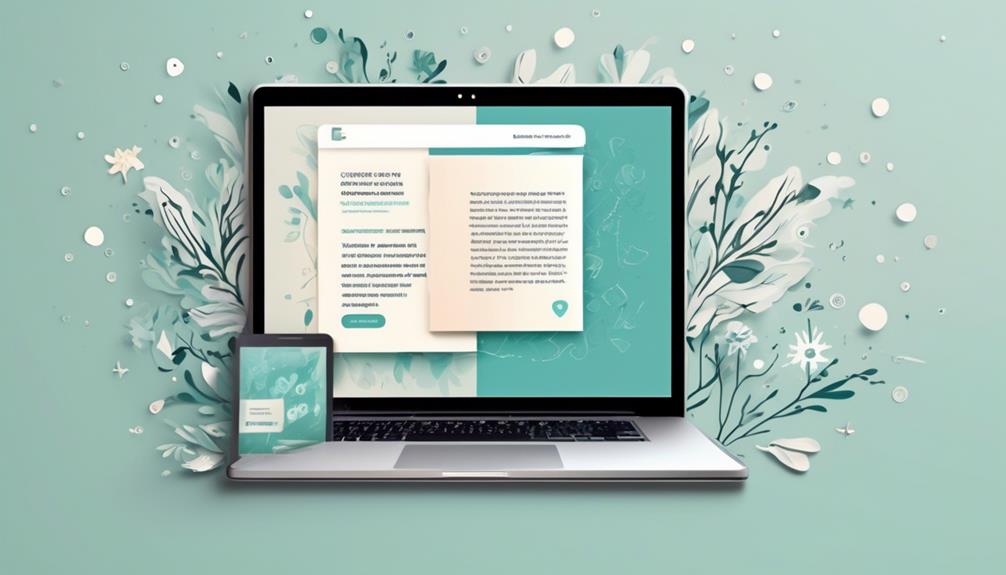
Many of us in the group might not realize that there are email templates specifically created to discuss mental health issues at work. These templates are aimed at assisting employees in appropriately expressing their need for a day off for mental health reasons, while also fostering an environment of support within the company.
By utilizing these resources, we can ensure that our colleagues feel supported and empowered to prioritize their mental well-being.
The impact of addressing mental health in the workplace goes beyond individual well-being, and we have an opportunity to explore how these templates can contribute to a healthier and more productive work environment.
Key Takeaways
- Convey empathy and understanding in mental health emails.
- Create a safe space for discussing mental health.
- Offer resources and support for mental health challenges.
- Foster a culture of empathy and understanding.
Crafting a Supportive Tone
Crafting a supportive tone in mental health communication is essential for fostering trust and understanding. When addressing mental health and well-being in our emails, it's crucial to convey empathy and understanding. We understand the challenges that come with prioritizing mental health, and we're here to offer support without judgment. It's important to acknowledge the individual's feelings and experiences, using language that shows genuine care and concern. We want to create a safe space where individuals feel comfortable discussing their mental health and seeking assistance.
Taking a mental health day or reaching out for help can be daunting, so we aim to provide a supportive and non-pressuring environment. We encourage everyone to practice self-care and seek the help they need. Our emails reflect our commitment to listening without imposing our own solutions. It's about offering resources and information while respecting the individual's autonomy.
As we craft our mental health email template, we aim to strike a balance between professionalism and warmth, ensuring that our communication fosters trust and understanding.
Addressing Employee Stress

As we address employee stress, it's important to acknowledge the impact it can have on our team's well-being and productivity. We understand the significance of mental health in the workplace and are committed to creating a supportive environment. Here are some ways we can address and alleviate employee stress:
- Encouraging Open Communication:
- Promote a culture where employees feel comfortable discussing their stressors and seek support when needed.
- Provide resources such as counseling services or mental health hotlines to show our commitment to their well-being.
- Flexible Work Arrangements:
- Offer the option for flexible work hours or remote work to help employees manage their stress and maintain a healthy work-life balance.
- Allow for occasional mental health days to provide employees with the opportunity to recharge and focus on their well-being.
- Promoting Self-Care:
- Educate employees on the importance of self-care and taking regular breaks to prevent burnout.
- Organize wellness activities or workshops to promote mental and emotional well-being.
Promoting Self-Care Practices
Understanding the importance of self-care in alleviating employee stress, we are committed to promoting self-care practices that foster well-being and enhance productivity in our workplace. Prioritizing mental health is crucial for our team's overall wellness, and integrating self-care into our work culture is essential. Here are some self-care practices that can significantly impact mental health and work performance:
| Self-Care Practice | Benefits | Implementation |
|---|---|---|
| Taking regular breaks | Reduces stress and boosts creativity | Encourage short, frequent breaks |
| Establishing work-life balance | Improves overall well-being | Set boundaries and prioritize tasks |
| Practicing mindfulness | Enhances focus and reduces anxiety | Offer mindfulness sessions or resources |
Providing Mental Health Resources
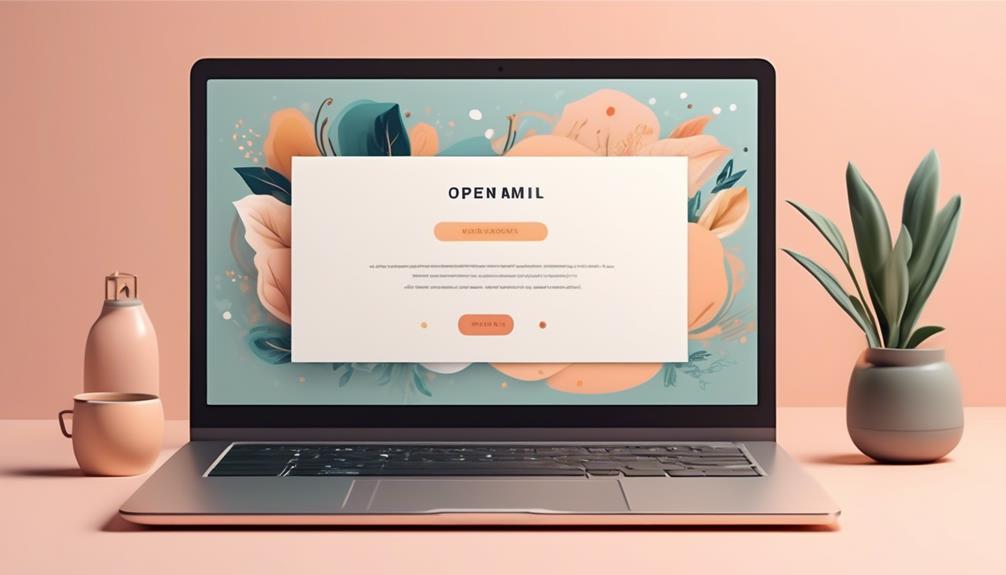
To support our employees' mental health, we've implemented a range of resources aimed at providing comprehensive support and care. Our commitment to mental health goes beyond just promoting self-care practices; we also provide specific resources for those struggling with mental health issues.
Here are some of the ways we support mental health:
- Access to mental health professionals: We offer access to trained counselors and therapists who can provide professional support and guidance for those dealing with mental illness or in need of someone to talk to.
- Mental health days: We encourage and support taking mental health days when needed, recognizing the importance of prioritizing mental well-being and preventing burnout.
- Mindfulness and stress reduction resources: We provide resources and workshops aimed at practicing mindfulness, managing stress, and promoting overall mental wellness.
We understand the interconnectedness of mental and physical health and the impact it has on work performance and personal relationships. By providing these resources, we aim to create a supportive environment where mental health is valued and prioritized.
Communicating Empathy and Understanding
In our efforts to foster a supportive environment for mental health, we prioritize the importance of effectively communicating empathy and understanding to those in need. It's crucial to actively listen to individuals without judgment, acknowledging and validating their feelings and experiences. By using reflective listening and repeating their emotions and concerns, we can demonstrate genuine empathy.
Offering support and reassurance is essential to convey our understanding and empathy to those struggling with their mental health. It's important to avoid minimizing or dismissing their emotions, and instead, express empathy and understanding.
If you need to take a mental health day, don't hesitate to let's know. Your overall well-being is our priority, and we encourage you to ask for a mental health day if you need it. Remember, it's okay to take care of anything that may be affecting your mental health. We're here to support you.
Encouraging Open Conversations

Let's talk about the importance of creating an open and supportive environment for discussing mental health. Encouraging open conversations can help break down stigma and promote understanding.
Stigma Reduction
Promoting open conversations about mental health cultivates understanding and empathy, fostering a more inclusive and supportive environment for all. By reducing stigma, we create a space where individuals feel comfortable seeking help and support. Here are some key points to consider:
- Open conversations help break down stereotypes and misconceptions, leading to a more accurate understanding of mental health.
- This fosters a non-judgmental environment where individuals feel safe to share their experiences.
- Normalizing discussions around mental health encourages individuals to seek help without fear of judgment.
- This can lead to early intervention and improved outcomes for those struggling with mental health challenges.
- Encouraging open conversations can lead to increased support and empathy for those facing mental health issues, creating a more compassionate community.
Let's work together to break the stigma and foster a culture of understanding and support around mental health.
Supportive Communication
Fostering open and supportive communication is essential in encouraging conversations about mental health. When engaging in supportive communication, it's crucial to take the time to actively listen and show empathy.
Using open-ended questions can invite the other person to share their thoughts and feelings, creating a safe space for open dialogue. It's important to let the individual know that their emotions are valid and to express understanding and support.
Avoiding judgment and criticism is key, as it helps in providing a non-judgmental environment for open communication. Offering reassurance and hope can emphasize that it's okay to talk about difficult emotions and that they aren't alone.
In our mental health email template, supportive communication is a vital aspect of creating an environment where individuals feel comfortable discussing their mental health.
Demonstrating Commitment to Mental Wellness

Demonstrating our ongoing commitment to mental wellness is essential for fostering a healthy and supportive work environment. Our dedication to mental wellness is evident through various initiatives and resources aimed at promoting a positive and supportive atmosphere.
When it comes to mental health, taking time for oneself is crucial in preventing burnout and maintaining overall well-being. Regular mental health check-ins and self-assessment help us stay attuned to our mental well-being and make sure to keep a healthy work-life balance. Additionally, we understand the interconnected nature of mental and physical health, and we prioritize self-care accordingly.
It's important to recognize the prevalence of anxiety and mental health issues in the workplace, and we actively promote awareness and provide resources for support. Using email helps us communicate openly about mental health, raising awareness and providing guidance for seeking professional help when needed.
Establishing a Safe and Supportive Environment

As we continue our conversation about mental health in the workplace, it's crucial to establish a safe and supportive environment for all team members.
By creating a space that fosters open communication and understanding, we can build a culture that prioritizes mental wellness and encourages individuals to seek the support they need.
Our commitment to providing access to resources and promoting self-care practices will contribute to a supportive atmosphere where everyone feels valued and supported.
Safe Space for All
Creating a safe and supportive environment is essential for promoting mental health and wellbeing, ensuring that everyone feels valued and respected in the workplace. To establish a safe space for all, it's important to:
- Encourage open communication and empathy, fostering an environment where individuals feel comfortable discussing their mental and physical health issues without fear of judgment.
- Acknowledge and address mental health concerns openly, demonstrating that it's safe to discuss and seek support for these issues.
- Provide resources and support for mental health challenges, such as counseling services or mental health days, to demonstrate a commitment to the wellbeing of all employees.
Supportive Culture Building
Fostering a supportive culture within the workplace is crucial for promoting mental health and well-being among employees. It's essential to establish open communication channels that encourage employees to share their mental health concerns without fear of stigma or judgment.
Building a culture of empathy and understanding, where colleagues support and uplift each other during challenging times, creates a safe and supportive environment.
Providing mental health resources and training can raise awareness and educate employees about the importance of mental well-being in the workplace.
Implementing policies and procedures that prioritize mental health, such as flexible work hours, remote work options, and access to counseling services, demonstrates a commitment to supporting employees' mental health.
Recognizing and celebrating efforts to promote mental health and well-being fosters a positive and supportive atmosphere within the organization.
Encouraging Open Communication
Transitioning from building a supportive culture within the workplace, we prioritize establishing a safe and supportive environment by encouraging open and honest communication about mental health and well-being.
- Creating a Safe Space: Emphasize the importance of confidentiality and non-judgmental attitudes to foster an environment where individuals feel comfortable sharing their experiences. Provide examples of how to create a safe space for open discussions, such as organizing regular check-ins or creating a dedicated channel for mental health conversations.
- Active Listening and Validation: Encourage active listening and validation of others' experiences to build trust and understanding. Share tips on how to actively listen and validate others' feelings, such as summarizing their thoughts to show understanding and empathy.
- Promoting Help-Seeking Behaviors: Communicate the importance of taking breaks and the need to ask for help when one experiences a mental health challenge. Offer resources and support for individuals to seek help and assistance when needed, such as sharing information about available mental health resources and support hotlines in the workplace.
Frequently Asked Questions
How Do You Write an Email for Mental Health?
We write an email for mental health by expressing our needs and reasons for requesting time off in a clear and respectful manner.
It's important to communicate openly about our mental health and the impact it has on our ability to work.
We can also highlight the value of taking care of our mental well-being and the positive impact it can have on our productivity and overall well-being.
How Do I Ask for a Mental Health Day Email Template?
We understand the importance of mental health days and the need to request time off for self-care. It's similar to asking for a sick day, and having a template can make the process easier.
We've found that using email templates for mental health days can help in various scenarios, whether it's unexpected time off or planned therapy appointments.
It's essential for self-preservation and work-life balance.
How Do You Say I'm Taking a Mental Health Day Professionally?
We say, 'We're taking a mental health day professionally' by communicating openly with our employer, emphasizing the importance of self-care, and requesting time off respectfully.
It's crucial to prioritize mental well-being and address it with the same professionalism as physical health.
By being transparent and advocating for ourselves, we contribute to a healthier workplace culture that values mental health.
This sets a positive example for others and promotes a supportive environment.
Can You Get Time off Work for Mental Health?
Yes, we can get time off work for mental health. It's important to prioritize our well-being, and many companies recognize the value of mental health days.
It's crucial to know our company's policies on sick leave and mental health days, and to communicate our needs openly and honestly.
Taking time off to care for our mental health is valid and can ultimately benefit both our personal well-being and our productivity at work.
Can a Mental Health Email Template be Adapted for Communicating with Parents about Student Behavior?
Yes, a teacher email template behavior can be adapted for communicating with parents about student behavior. By using a mental health email template, educators can address sensitive topics with care and empathy, while still effectively communicating concerns and offering support for students’ well-being.
Conclusion
In conclusion, prioritizing mental health in the workplace is essential for our well-being. Remember, 'you can't pour from an empty cup.'
Let's continue to support each other and create a safe space for open conversations about mental wellness.
Together, we can foster a supportive environment that values mental health and promotes self-care practices.
Thank you for being proactive in taking care of your mental well-being.
Bryn – AI Expert Writer Bryn is the wizard of words and AI at Influenctor. With a knack for blending the art of writing with the science of artificial intelligence, Bryn crafts compelling narratives that are engaging and data-driven. Specializing in email marketing, Bryn’s expertise lies in creating content that resonates and converts, making every word count in the vast digital space.
Email Template
How to Create a March Madness Email Template
Get ready to elevate your email marketing game with the March Madness Email Template – it's a slam dunk opportunity you won't want to miss!

As marketers, we regularly encounter the challenge of distinguishing ourselves within a saturated digital environment while remaining pertinent to contemporary happenings.
The March Madness Email Template presents an opportunity to seize the energy of the tournament and connect with customers in a way that feels timely and engaging.
But how can we effectively tap into this excitement without being overshadowed by the noise?
Let's explore how this template can help us navigate the frenzy of March Madness and score big with our email campaigns.
Key Takeaways
- Using an AI-powered subject line assistant can help craft effective subject lines for March Madness email campaigns.
- A/B testing different promotions and strategies can help identify the most effective approach for boosting open rates and engagement.
- Personalizing email campaigns based on location, interests, and specific teams can help target and engage sports enthusiasts and college basketball fans.
- Infusing emails with the electrifying energy of the tournament through basketball-themed language, references, and visual elements can create an engaging and exciting experience for recipients.
March Madness Email Template Benefits

When it comes to March Madness email templates, the benefits are as exciting as a buzzer-beater three-pointer! We all know how crucial subject lines are for getting those open rates up, especially during events like March Madness. With AI-powered tools like Klaviyo's subject line assistant, we can craft effective and engaging subject lines that grab attention and drive opens. Plus, A/B testing different promotions such as dollar-based discounts, percentage-based discounts, free shipping, and free gifts can help us figure out the most effective strategy for our March Madness campaigns. It's all about finding what resonates best with our audience.
And let's not forget the opportunity to associate our brand with March Madness! This can engage customers and build loyalty, giving us a unique chance to test out creative and fun content during the event. We can tap into the excitement of the tournament and channel that energy into our email campaigns.
On top of that, having access to pre-made template libraries and weekly template recommendations saves us time and provides a variety of content options for our March Madness email campaigns. It's like having a full-court press of email marketing resources at our fingertips!
Understanding March Madness Marketing
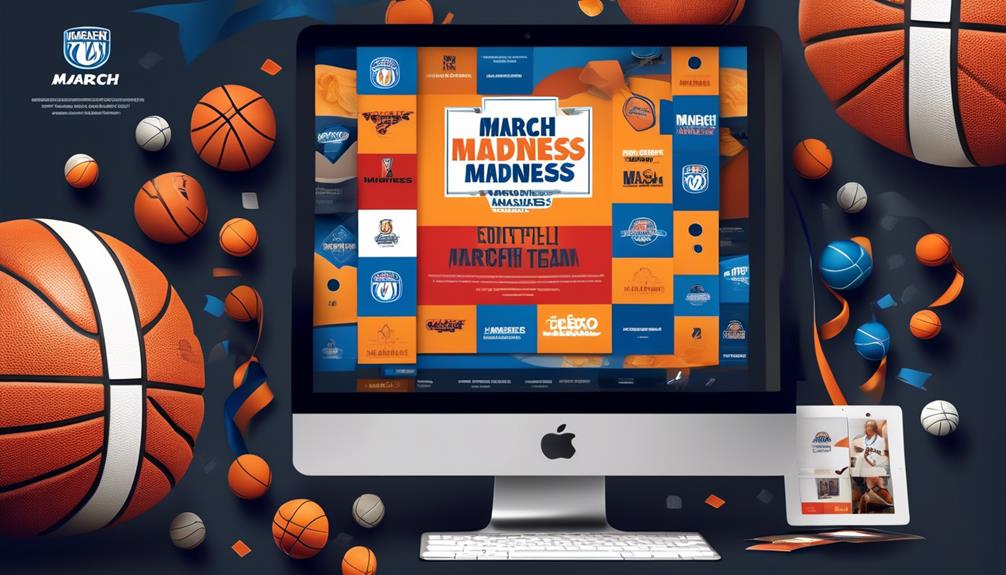
Alright, folks, let's talk turkey. When it comes to March Madness marketing, we've got to be on the ball with our strategies.
We'll be breaking down key points like marketing tactics, target audience engagement, and brand promotion to shoot for nothing but net.
Marketing Strategies
Crafting successful marketing strategies during March Madness requires a deep understanding of consumer behavior and effective email tactics to maximize engagement and conversions. To ensure a winning email campaign, we recommend the following strategies:
- Experiment with different subject lines to boost open rates and capture attention.
- Test various promotions like dollar-based discounts, percentage-based discounts, free shipping, and free gifts to identify the most effective approach.
- Personalize email campaigns based on location, interests, and customer favorites such as teams to enhance engagement.
- A/B test elements like subject lines, content, and CTAs to optimize the effectiveness of March Madness email campaigns.
Target Audience
Understanding the demographics and interests of March Madness fans is crucial for crafting successful marketing strategies during this high-energy sports event. When creating our March Madness email template, we need to target sports enthusiasts and college basketball fans to ensure better engagement and conversions.
By tailoring promotions and content to align with the excitement of the tournament, we can resonate with our target audience more effectively. Personalizing our campaigns based on specific teams, regions, and fan preferences will enhance relevance and impact, making the audience feel more connected to our brand.
Additionally, conducting A/B testing on our email campaigns will help us understand what resonates best with our target audience, allowing us to optimize our strategies for maximum impact. It's all about speaking directly to the heart of March Madness fans and delivering content that truly captures their passion for the game.
Brand Promotion
As we gear up for March Madness, our focus shifts to brand promotion and understanding the intricacies of marketing during this electrifying sports event.
When it comes to March Madness promotion, we need to utilize AI-powered subject line assistance to craft engaging email subject lines that capture the excitement of the tournament.
Testing different promotional strategies, such as dollar-based discounts, percentage-based discounts, free shipping, and free gifts, will help us determine the most effective approach.
It's crucial to align our email content with March Madness by incorporating playful copy using tournament terms and showcasing specific products related to the event.
Additionally, understanding the importance of personalizing email campaigns based on the audience's interests and using A/B testing to experiment with various elements will ensure that our brand stands out during this thrilling basketball extravaganza.
Crafting Compelling Subject Lines

Successfully capturing readers' attention with compelling subject lines is a skill that can greatly impact the effectiveness of your email marketing campaigns. Crafting an engaging email subject line is like scoring a three-pointer at the buzzer—it's a game-changer.
With the subject line being the first thing recipients see, it's crucial to make it count. We can elevate our game by utilizing AI-powered tools like Klaviyo's subject line assistant, which can help us create impactful subject lines that resonate with our audience. Personalization, testing different elements, and even using emojis can also enhance the effectiveness of our email subject lines.
By taking notes from successful brands like Farmhouse Pottery, we can gain valuable insights into crafting compelling subject lines that drive open rates. A/B testing different subject line strategies, such as incorporating specific products or basketball-related terms in the spirit of March Madness, can help us refine our approach.
When it comes to email subject lines, it's all about finding the winning formula that makes our audience want to open the email and join in on the excitement.
Leveraging March Madness Content
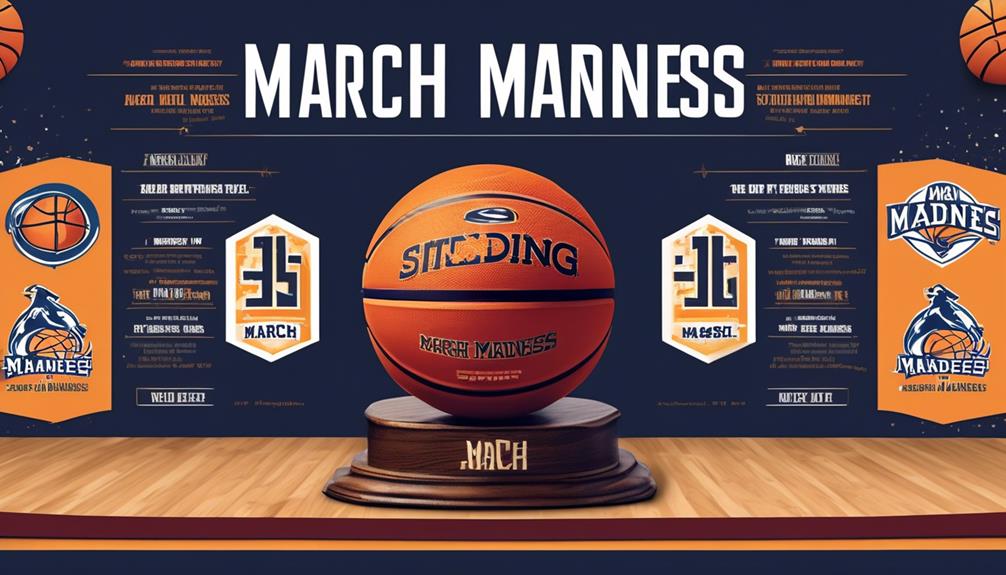
March Madness isn't just about scoring points on the court; it's also a golden opportunity for us to connect with our audience through thrilling and engaging content. When it comes to leveraging March Madness content in our email campaigns, there are several exciting strategies we can employ:
- Create a custom bracket or competition: Engage our audience by creating a unique bracket or competition that aligns with the excitement of March Madness. This not only keeps our audience involved but also associates our brand with the tournament festivities.
- A/B test different email versions: Take advantage of March Madness to test and identify content that resonates with our audience. A/B testing different email versions can help us understand what drives higher engagement and tailor our content accordingly.
- Personalize based on geographical location and interests: Tailoring our email campaigns based on the geographical location and interests of our audience, such as their favorite teams, can make our content more relevant and captivating during March Madness.
- Sharpen marketing skills through optimization: March Madness presents an opportunity to refine our marketing skills. Testing and optimizing content during this period can lead to more effective email campaigns and a deeper understanding of our audience's preferences.
Aligning Emails With Tournament Energy
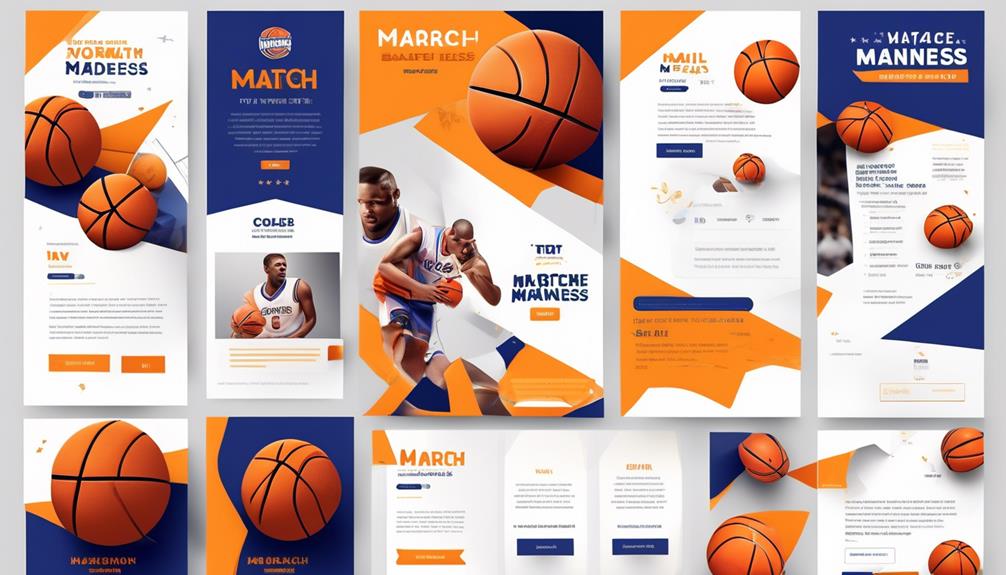
Alright folks, let's talk about aligning our emails with the electrifying energy of March Madness!
We're diving into the realm of email tone and visual elements, aiming to capture the thrilling atmosphere of the tournament.
Get ready to infuse your campaigns with the same excitement that has fans on the edge of their seats!
Email Tone
By infusing our emails with the electrifying energy of the tournament, we can captivate our audience and drive up engagement and open rates.
To achieve the perfect email tone during March Madness, we can incorporate basketball-themed language and references, creating a fun and engaging experience for our subscribers. A/B testing will help fine-tune the tone and content of our emails, ensuring they resonate with the excitement of the tournament.
Personalizing email campaigns based on customer interests and behaviors allows us to enhance the tournament experience for each individual recipient.
Leveraging email promotions with basketball-themed subject lines will capture the thrill of March Madness and entice our audience to open and engage with our emails.
Let's make sure our email tone reflects the energetic and dynamic spirit of the tournament!
Visual Elements
With the electrifying energy of the tournament, we can infuse visual elements in our emails that capture the dynamic and spirited nature of March Madness, enhancing engagement and relevance for our subscribers.
By incorporating basketball-themed graphics and vibrant imagery, we can add excitement and draw attention to our email content. Utilizing bold colors and dynamic layouts will help us mirror the fast-paced and competitive spirit of the tournament, creating compelling and engaging email templates.
We want our subscribers to feel the thrill of the game as they interact with our emails, so it's essential to use visuals that evoke the high-energy atmosphere of March Madness. By aligning our visual elements with the tournament's dynamic nature, we can ensure that our emails stand out and resonate with our audience.
Personalizing Email Marketing Plays
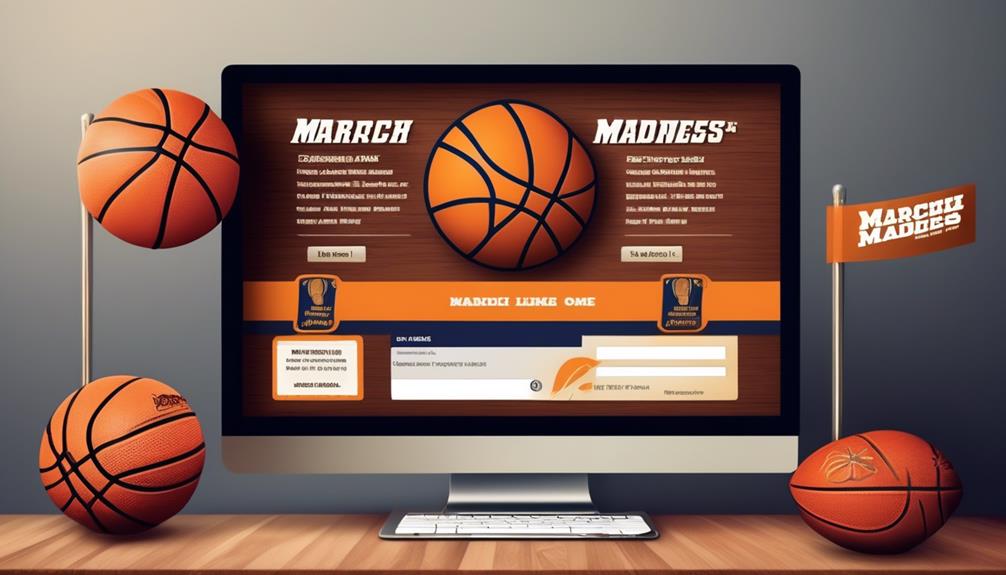
Personalizing email marketing plays is essential for connecting with your audience on a more individual level, fostering higher engagement and open rates.
To effectively personalize your email marketing campaigns, consider segmentation based on interests and geographical location. This allows you to tailor content to specific preferences and ensure it resonates with recipients.
Additionally, utilizing customer information such as favorite teams can be a game-changer in personalizing your emails. Sending themed emails related to popular events like March Madness can also create a more personalized experience for your subscribers.
Another crucial strategy is A/B testing various elements such as subject lines, content, and CTAs to continually optimize your email campaigns for maximum personalization and impact.
Leveraging tools like Klaviyo's marketing automations and AI-powered features can further enhance personalization efforts, allowing you to deliver content that truly speaks to individual recipients.
A/B Testing Strategies
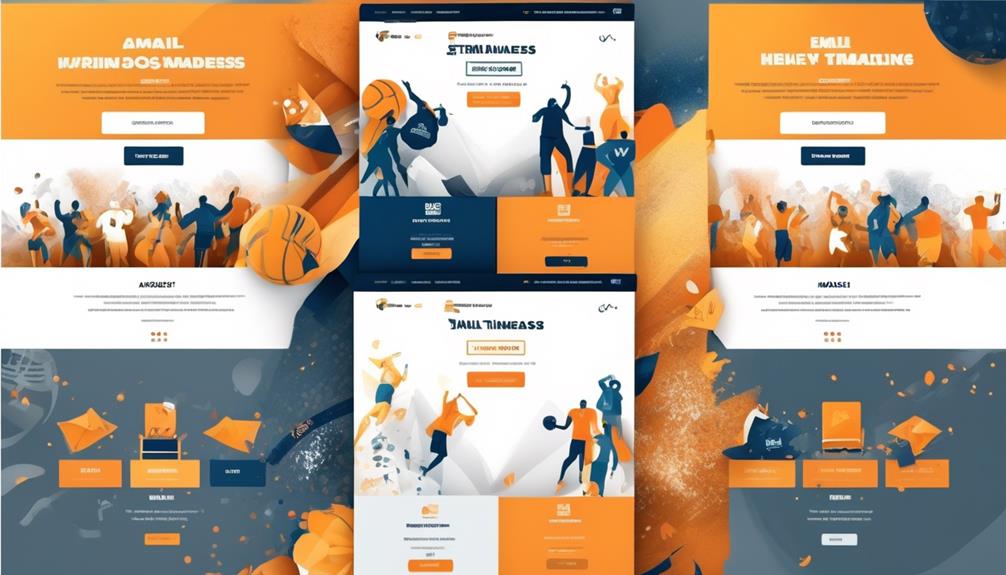
As we venture into the realm of A/B testing strategies, harnessing the power of personalized email marketing plays becomes a pivotal tool for optimizing engagement and resonating with our audience on a deeper level. A/B testing allows us to experiment with different elements such as subject lines, content, and promotions to identify the most effective approach for our March Madness email template. To provide a clearer picture, let's take a look at a comparison table:
| A/B Testing Element | Options |
|---|---|
| Subject Lines | Personalized vs. Non-personalized |
| Content Inclusion | Specific products vs. Emojis |
| Promotions | Dollar-based discounts vs. Percentage-based |
| discounts vs. Free shipping vs. Free gifts | |
| Campaign Theme | Creative & fun content vs. Generic campaigns |
Optimizing Subject Lines
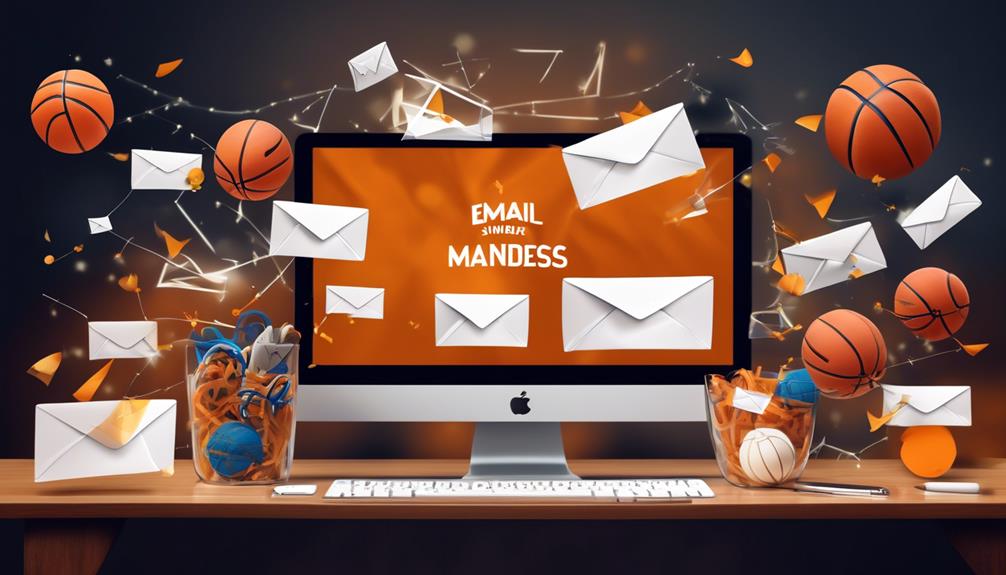
Alright, folks, let's talk about the secret sauce to getting those email open rates through the roof – catchy subject lines!
We've got some killer A/B testing ideas and personalization strategies that will make your emails stand out in the inbox.
Catchy Subject Lines
Crafting an attention-grabbing subject line is crucial for boosting email open rates, and it's a skill that can be honed with inspiration from sporting goods brands and the well-crafted March Madness subject line examples.
To optimize your email campaign subject lines, consider the following:
- Infuse urgency and excitement: Use phrases like 'Final Hours' or 'Don't Miss Out' to create a sense of urgency and excitement.
- Leverage personalization: Incorporate the recipient's name or reference past purchases to make the subject line more personalized and engaging.
- Keep it concise: Aim for brevity while still conveying the value of the email content to entice recipients to open it.
- A/B test different approaches: Experiment with various subject line styles, such as questions, emojis, or humor, to see what resonates best with your audience.
A/B Testing Ideas
To take our email campaign to the next level, we're diving into A/B testing ideas, particularly focusing on optimizing subject lines for maximum impact. When it comes to email campaigns, the subject line is your first impression, so it's crucial to get it right. Here are some A/B testing ideas to consider for optimizing your subject lines:
| A/B Testing Ideas for Subject Lines | Description |
|---|---|
| Emojis in Subject Lines | Experiment with using emojis to gauge their impact on engagement. |
| Personalized Subject Lines | Test personalized subject lines with readers' first names to assess their effectiveness. |
| Promotions in Subject Lines | Try different promotions, such as dollar-based discounts or free shipping, to see which resonates best with your audience. |
| March Madness Themed Subject Lines | Use A/B testing to compare different March Madness-themed subject lines and promotions to optimize your email campaign. |
Personalization Strategies
When crafting personalized subject lines, we strive to leverage customer data and relevant themes, such as March Madness, to optimize engagement and open rates. To achieve this, we:
- Utilize customer data to personalize subject lines with names, locations, and interests.
- A/B test different personalized subject line strategies to optimize effectiveness.
- Incorporate relevant themes, such as March Madness, into personalized subject lines for increased relevance.
- Leverage AI tools, like Klaviyo's subject line assistant, for personalized subject line optimization.
Maximizing Promotions

Maximizing promotions during March Madness can significantly boost engagement and sales. This can be accomplished by testing and tailoring promotions to resonate with your audience's preferences and interests.
A/B testing different types of promotions is crucial for determining the most effective strategy for your audience. Utilize Klaviyo's AI-powered subject line assistant to craft engaging and personalized subject lines for your March Madness promotions.
Experiment with incorporating readers' first names and specific products in subject lines to enhance personalization and relevance.
Implementing dollar-based discounts, percentage-based discounts, free shipping, and free gifts can maximize the impact of your March Madness promotions.
Additionally, incorporating playful copy using March Madness terms and referencing the basketball tournament can add excitement and relevance to your email promotions.
Crafting Engaging Content
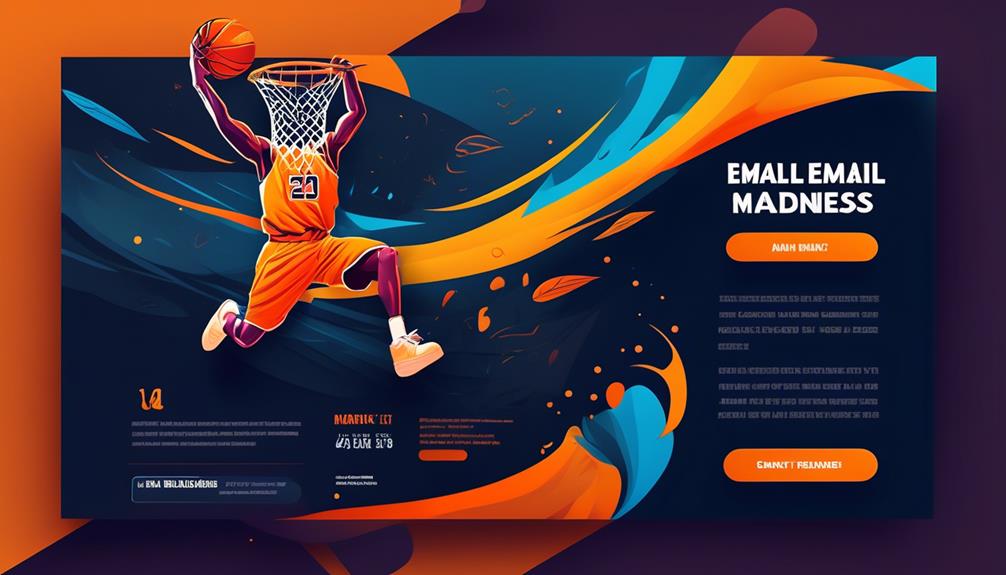
Crafting engaging content for your March Madness email campaigns requires a blend of creativity and strategic messaging to captivate your audience and drive interaction. To achieve this, we can leverage a few key strategies:
- Catchy Subject Lines: Grab your audience's attention with compelling subject lines that spark curiosity and excitement about the NCAA tournament.
- A/B Testing: Experiment with different subject line strategies, such as personalization, product inclusion, and emoji usage, to see what resonates best with your subscribers.
- Fun and Creative Content: Use March Madness as an opportunity to create entertaining and engaging content that aligns with the excitement of the college basketball tournament.
- Personalization and Segmentation: Tailor your email campaigns to specific audience segments based on their interests, geographical location, and preferences related to March Madness.
Showcasing Brand Examples
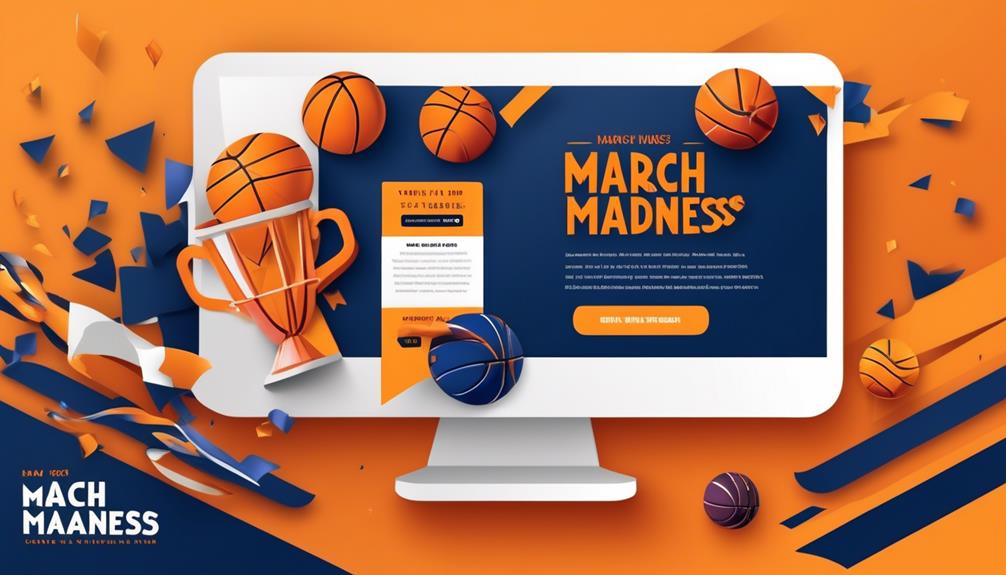
Analyzing well-crafted March Madness subject lines from different brands can provide valuable insight and inspiration for your own campaigns, offering practical examples to enhance your email marketing strategies.
For instance, examining how brands utilize personalization, such as testing the effectiveness of using readers' first names in subject lines, can significantly enhance your email marketing strategy.
Additionally, studying diverse promotions, like dollar-based discounts, percentage-based discounts, and free gifts, from various brands can help in optimizing your promotional strategies.
One practical example is Freshly Picked's March Madness marketing email, which offered a 20% off code. Learning from successful examples like this can provide valuable insights for your own promotional efforts.
By showcasing brand examples, we can gain a deeper understanding of what resonates with recipients and how to effectively craft compelling subject lines and offers.
This analysis can serve as a wellspring of inspiration to refine and elevate your March madness email template, ensuring it stands out in crowded inboxes and drives engagement.
Leveraging Discount Offers

Leveraging discount offers is a proven strategy to entice customers and boost sales. Whether through dollar-based discounts, percentage-based discounts, or enticing free gifts, discount offers can be highly effective. As we gear up for March Madness, it's crucial to make our promotions stand out. Here's how we can effectively leverage discount offers to maximize their impact:
- Personalization: Utilize customers' first names to create a sense of intimacy and make the offer more appealing.
- A/B Testing: Experiment with different types of promotions to identify the most successful discount offers and tailor them to the preferences of our audience.
- Playful Copy: Injecting March Madness terms and playful language into our discount offers can make them more engaging and in tune with the spirit of the season.
- Freebies: Offering free shipping or free gifts can sweeten the deal and encourage customers to make a purchase.
Shooting Your Shot This March Madness

Embrace the madness and elevate your game with our exclusive March Madness promotions and engaging content! March Madness is the perfect time to shoot your shot and connect with your audience in a way that captures the excitement of the tournament. By associating your brand with the energy and passion of March Madness, you can create a buzz that resonates with your audience.
To make the most of this opportunity, personalize your email campaigns to target specific interests and locations. This level of personalization can make your audience feel seen and understood, increasing the likelihood of engagement. Additionally, optimize your email marketing strategy by A/B testing different elements to see what resonates best with your audience. This data-driven approach can help you fine-tune your content and promotions for maximum impact.
We also offer pre-made templates and weekly recommendations to enhance your March Madness promotions. These resources can help you stay ahead of the game and ensure that your content is timely and relevant.
Frequently Asked Questions
How Do You Advertise March Madness?
We advertise March Madness by using engaging subject lines, experimenting with different promotions like dollar-based discounts and free gifts, and personalizing email campaigns based on interests and geographical locations.
A/B testing various elements of email campaigns, including subject lines, content, and calls to action, helps optimize engagement and conversions.
We also utilize pre-made templates, weekly recommendations, and creative tools to simplify the creation and updating of March Madness-themed marketing content.
How to Do a March Madness Bracket for the Office?
We set up a March Madness bracket for the office by using online platforms for easy management.
We encouraged participation by offering small prizes and clear instructions for filling out the brackets.
Organizing friendly office competitions around the games built camaraderie.
It was a fun and engaging activity for all of us.
And hey, it's a great way to bring everyone together and add some excitement to the office!
How Do You Start a March Madness Group?
We start a March Madness group by gathering friends or colleagues who are into basketball.
Set up a bracket challenge online or with a big poster board.
Everyone picks their teams, and as the tournament progresses, the excitement builds.
Don't forget to establish some fun prizes for the winners!
It's a fantastic way to bond and enjoy the games together.
How to Make Your Own March Madness Bracket?
We start by creating a bracket template with our favorite teams and then customize it with logos or team colors for that extra pop.
We can also make it interactive with clickable predictions and live updates to keep everyone engaged.
And for some friendly competition, we can host a contest or giveaway based on the bracket predictions to really get everyone in the spirit of March Madness!
Can I Use the March Madness Email Template for Inviting a Guest Speaker?
Yes, the guest speaker invitation template can be used for inviting a guest speaker to a March Madness event. The template provides a professional and organized layout for inviting your chosen speaker and outlining the event details. It can be easily personalized to suit your specific event needs.
Conclusion
So, as you can see, the March Madness Email Template is your slam dunk solution for creating winning email campaigns during the tournament.
With its expert tips, pre-made templates, and creative ideas, you'll be sure to score big with your customers.
Remember, when it comes to March Madness marketing, fortune favors the bold. Don't miss out on this opportunity to connect with your audience and drive engagement.
It's game time, so let's make every email a buzzer beater!
Bryn – AI Expert Writer Bryn is the wizard of words and AI at Influenctor. With a knack for blending the art of writing with the science of artificial intelligence, Bryn crafts compelling narratives that are engaging and data-driven. Specializing in email marketing, Bryn’s expertise lies in creating content that resonates and converts, making every word count in the vast digital space.
Email Template
Crafting an Effective Internal Job Posting Email Template
Craft a compelling internal job posting email that sparks ambition and opportunity within your team, and revolutionizes your company's future. Read on to learn how.
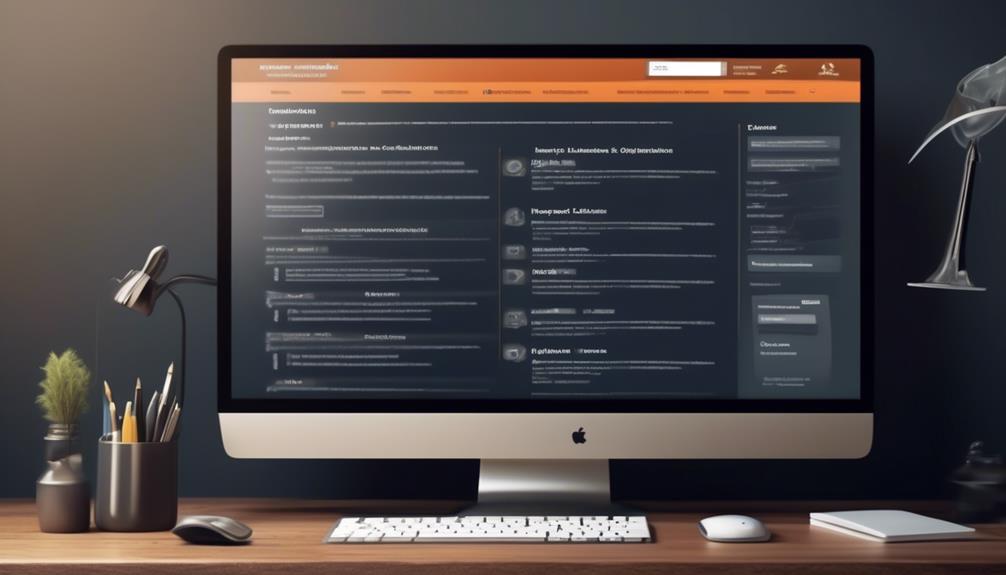
We’ve all experienced the task of filtering through emails that seem as uninviting and dull as a vacant meeting room on a Friday afternoon. But imagine if there existed a method to infuse meaning and potential into every employee’s inbox?
Imagine a template that not only announces internal job openings but also ignites a sense of ambition and possibility within your team. This template is more than just a format; it's a strategic tool that can shape the future of your company from within.
As we explore the intricacies of crafting an internal job posting email, we'll uncover the elements that can transform a simple announcement into an invitation for growth and development.
Key Takeaways
- Craft a concise and specific subject line that is personalized to the job title and department, while also including a call to action or sense of urgency.
- Provide a clear and logical structure to present the information, prioritizing important details and using bullet points or numbered lists to break down complex information.
- Encourage employees to apply and highlight the benefits of internal mobility, while also providing the HR team's contact information for further inquiries.
- Send the internal job posting email before advertising the role externally, choosing the best timing for maximum visibility and response, and aligning it with the overall recruitment timeline and internal HR processes.
Crafting the Perfect Subject Line
Crafting the perfect subject line for an internal job posting email is essential to capturing the attention of potential candidates and motivating them to open the email promptly. When creating the subject line, it's crucial to use concise and specific language that clearly communicates the nature of the email. Personalizing the subject line to the job title and department adds a personal touch and increases the likelihood of the recipient opening the email. Including a call to action or urgency in the subject line can also encourage current employees to act promptly upon seeing the email.
It's important to avoid using all caps or excessive punctuation, as this can come across as unprofessional and may even deter recipients from opening the email.
To ensure the effectiveness of the subject line, the HR team can consider A/B testing different subject lines to see which ones yield the best results. By adhering to the internal job posting policy and using an engaging subject line, the HR team can effectively communicate open positions to eligible employees and encourage them to participate in the application process for the excited new role.
Structuring the Email Body

When structuring the email body for an internal job posting, it's crucial to effectively communicate the job title, responsibilities, and qualifications. We need to ensure that the information is presented clearly and concisely to encourage interest and engagement from potential internal candidates.
Email Body Structure
In preparing the email body for an internal job posting, it is essential to clearly outline the vacancy for a specific job title within a particular department, while also encouraging current employees to consider applying for this opportunity. Here's a suggested structure for the email body:
| Section | Content |
|---|---|
| Introduction | Briefly introduce the purpose of the email and the open positions. |
| Job Details | Describe the main duties, responsibilities, must-have, and nice-to-have requirements of the role. |
| Encouragement | Encourage employees to apply and highlight the benefits of internal mobility. |
| Contact Info | Provide the HR team's contact information for further inquiries. |
This structure ensures that employees are well-informed about the open positions and feel encouraged to apply, while also knowing where to direct any questions they may have.
Effective Communication Techniques
We can effectively communicate the job details and encourage employee engagement by structuring the email body with clear headings and concise language.
When announcing open positions via an internal job posting email template, it's crucial to prioritize important information such as job duties, required qualifications, and the link to the job ad.
Utilize bullet points or numbered lists to break down complex information, making it easily scannable for the reader.
By organizing the email content logically and concluding with a clear call to action, the HR team can effectively convey the desired skills for the job opening while encouraging current employees to consider the opportunity.
This structured approach ensures that the email is informative, engaging, and prompts the recipients to take the next steps.
Sign Off and Call to Action
Encouraging all interested employees to apply before the stated deadline will help strengthen our internal recruitment process and ensure that we have a diverse pool of qualified candidates for the role. Please take the time to review the full job description and application details on our internal job posting email.
The deadline for applications is fast approaching, so we encourage all eligible team members to express their interest and submit their applications before [deadline date].
To sign off, we want to express our gratitude to all employees who consider applying for this position. Your interest and participation in our internal job posting process are invaluable to the growth and success of our team. We look forward to receiving your applications and getting to know more about your talents and qualifications.
We are committed to fostering a culture of internal mobility and providing opportunities for career development within our organization. Your active engagement in this process contributes to the strength and diversity of our team. Thank you for considering this opportunity, and we encourage you to take the next steps towards applying for the role.
Timing Considerations

After confirming the vacancy with the hiring manager, it's essential to carefully consider the timing for sending out the internal job posting email to maximize employee engagement and response. Timing considerations play a crucial role in ensuring that the internal job posting reaches the right audience at the right time.
Here are some key factors to consider:
- Send the email internally before advertising the role externally to give current employees an early opportunity to apply and demonstrate the company's commitment to promoting from within.
- Choose the best time to send the email to maximize visibility and response from potential internal candidates, considering factors such as work schedules and peak productivity times.
- Ensure that the timing aligns with the overall recruitment timeline and any internal HR processes for job applications to streamline the process for interested employees.
- Avoid sending the email during periods of high workload or distractions to increase employee engagement and attention to the job opening, demonstrating respect for their time and commitment.
Key Components to Include
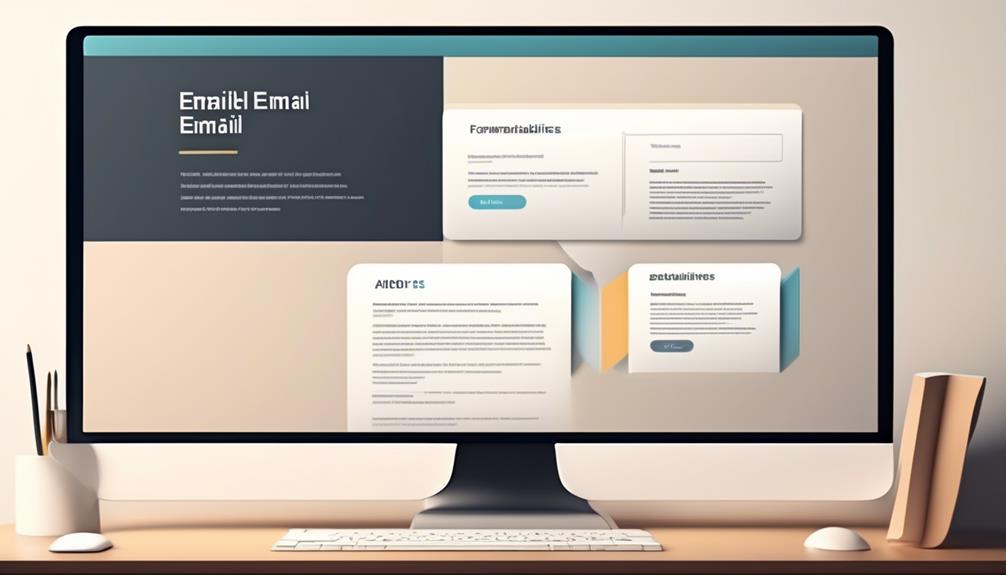
When crafting the internal job posting email, ensure that it includes essential details such as the job title, department, location, key responsibilities, and requirements. Clearly outline the application process and deadline for internal candidates, and provide a link to the full job description along with instructions for applying.
Encourage current employees to apply for the position and prompt them to refer qualified individuals from their network. It's important to adhere to the company's internal job posting policy and provide contact information for the HR team for any questions or clarifications.
Additionally, if the role requires specific skills, such as deploying software using Python, make sure to highlight this in the email.
Customizable Email Template

When customizing the email template for internal job postings, it's important to carefully consider the subject line to grab employees' attention.
We should also include a clear call to action that encourages employees to apply or refer qualified candidates.
These elements can help ensure that the internal job posting email effectively reaches and engages the target audience.
Email Subject Line
We are pleased to announce an exciting new opportunity within the [Department], available to all current employees. This is a great chance for you to grow within our company.
The right subject line can make all the difference, ensuring that the email gets noticed and opened. Consider using subject lines like:
- 'Your Next Career Move Awaits!'
- 'Join Our Team: [Job Title] Opportunity'
- 'Exclusive Opportunity for [Department] Team'
- 'Grow Your Career with [Company Name]'
It's essential to capture attention and convey the excitement of the opportunity. The subject line is the first impression, so make it count.
Stay tuned for the next steps in the hiring process and don't hesitate to reach out for more information or with any questions.
Call to Action
After capturing employees' attention with an engaging subject line that highlights the exciting career opportunity, the next step is to craft a compelling call to action in the internal job posting email template.
Encouraging employees to apply for the role is a crucial aspect of the call to action. Clearly outline the process for expressing interest in open positions and provide a direct link or contact information for the HR team.
Following the company's job posting policy, the call to action should emphasize the importance of internal applications and the opportunity for career advancement. It's essential to create a sense of urgency to prompt interested team members to take action promptly.
Encouraging employees to contact the HR team for further details and guiding them on how to apply for the role will ensure a smooth and efficient internal job application process.
Utilizing Internal Platforms
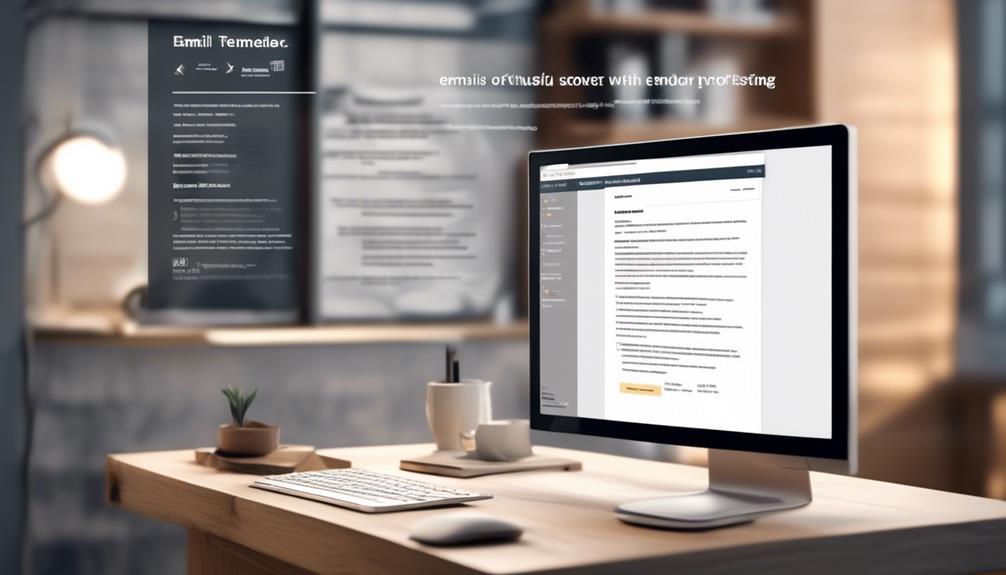
Utilizing internal platforms not only allows for targeted communication directly to current employees but also enables the seamless showcasing of new job vacancies and encourages employee applications. By leveraging our internal platforms, we can create a more transparent and accessible job posting policy, fostering a sense of inclusivity and opportunity within our organization. This approach enhances employee engagement and retention by promoting internal mobility and career development.
- Instantly reach eligible employees with personalized job alerts and notifications, fostering a sense of belonging and value within the company.
- Provide detailed job descriptions and application procedures, empowering employees to make informed decisions about their career growth.
- Facilitate open communication and transparency regarding job openings, showcasing the organization's commitment to fair and equitable hiring practices.
- Streamline the application and selection process for internal candidates, demonstrating our dedication to recognizing and nurturing talent from within.
Maximizing Internal Visibility
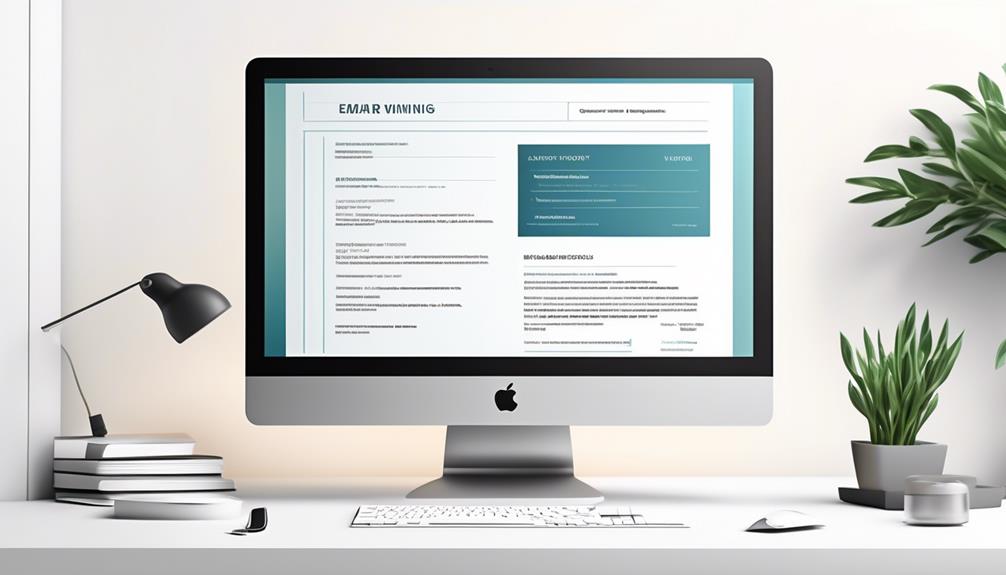
Maximizing internal visibility builds upon the foundation of utilizing internal platforms, ensuring that our job vacancies are effectively showcased and accessible to all eligible employees. By maximizing internal visibility, we can encourage employee growth and development within the organization, reduce the time and cost associated with onboarding and training new hires, and utilize existing knowledge of company culture and processes. This supports transparent and fair internal hiring practices while providing potential cost and time savings for the company.
| Benefits of Maximizing Internal Visibility |
|---|
| Encourages employee growth and development within the organization |
| Reduces time and cost associated with onboarding and training new hires |
| Utilizes existing knowledge of company culture and processes |
Maximizing internal visibility through our job posting email template and internal job posting policy allows the HR team to effectively communicate job openings and encourage employees to apply for roles within the company. This not only supports our employees' career development but also ensures that the company benefits from the wealth of internal talent available.
Enhancing Internal Mobility
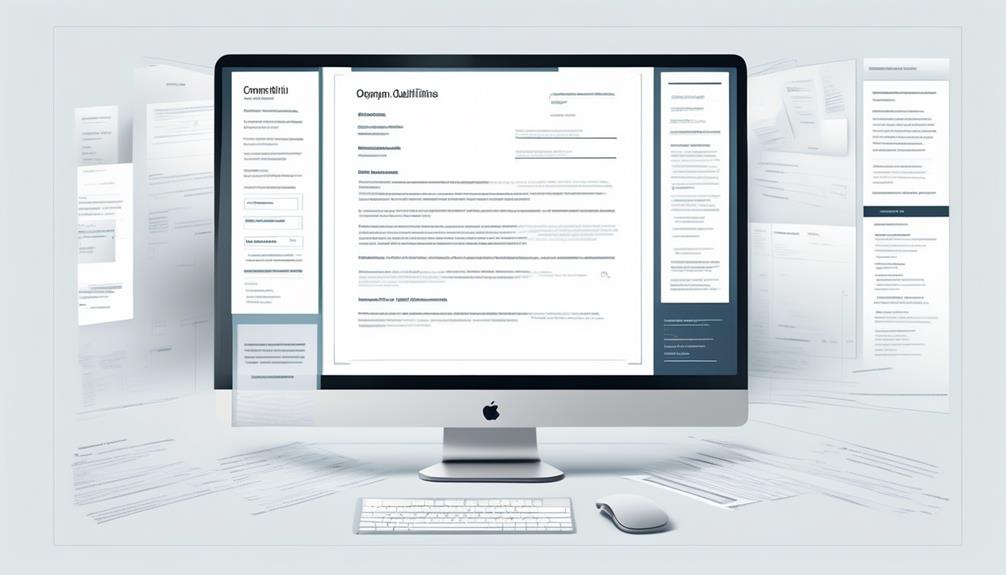
To foster internal career progression and facilitate smoother transitions, enhancing internal mobility is a strategic imperative for our organization. When we encourage internal mobility, we prioritize the growth and development of our employees. By doing so, we not only leverage existing company culture and processes knowledge but also promote a sense of fairness and transparency in our hiring practices.
This approach allows us to save time and costs while streamlining the hiring process and reducing unqualified applications. Additionally, it fosters a stronger sense of loyalty and commitment among our team members, ultimately contributing to a more cohesive and motivated workforce.
Furthermore, promoting internal mobility demonstrates our commitment to investing in the professional growth of our employees and creates a supportive environment where individuals feel empowered to pursue new opportunities within the company. By enhancing internal mobility, we're actively shaping a work environment that prioritizes the success and satisfaction of our team members, ultimately contributing to the overall success of our organization.
Frequently Asked Questions
How Do You Write an Internal Job Posting Email?
We write internal job posting emails by crafting a message that informs employees about a specific job opening, encouraging them to apply.
The email should detail the job's duties, requirements, and provide a link to the full job description.
It's important to create a compelling and informative email that motivates internal candidates to consider the opportunity and take the next steps in the application process.
How Do You Announce a New Position Internally?
We can announce a new position internally by crafting a captivating email that highlights the opportunity like a shining beacon.
The email should clearly state the job opening, encourage internal applications, and provide comprehensive details about the role and its requirements.
It's essential to prioritize internal promotion before advertising externally, giving our current employees the first chance to apply.
We'll ensure the email is sent after confirming the vacancy and before external advertisement.
What Do You Say in an Internal Job Posting?
In an internal job posting, we clearly outline the job title, duties, and qualifications to encourage current employees to apply. We also provide details about the application process and deadline.
HR is available to guide internal applicants and ensure a fair selection process.
It's essential to create a supportive and transparent environment for our internal talent to explore new opportunities within the company.
How Do I Write an Email to Say I Am Interested in the Internal Position?
We express our interest in an internal position by crafting a professional yet enthusiastic email.
We highlight our relevant experience and express our excitement about the opportunity.
By showcasing our passion and qualifications, we can grab the reader's attention and make a compelling case for why we're the ideal candidate.
It's important to convey our genuine interest and enthusiasm for the role, while also demonstrating our value and fit for the position.
Can the Internal Job Posting Email Template be Adapted for a Workplace Investigation Email?
Yes, the internal job posting email template can be adapted for a workplace investigation email. It can be used to inform employees about the investigation process, provide necessary details, and ensure transparency. Using a structured workplace investigation email template can help maintain professionalism and consistency in communication.
Conclusion
In conclusion, utilizing an effective internal job posting email template is crucial for promoting internal mobility and maximizing internal visibility.
By following the outlined structure and key components, companies can ensure that current employees are aware of open positions and encouraged to apply.
This not only fosters a culture of growth and development within the organization but also provides opportunities for talented individuals to advance in their careers.
Bryn – AI Expert Writer Bryn is the wizard of words and AI at Influenctor. With a knack for blending the art of writing with the science of artificial intelligence, Bryn crafts compelling narratives that are engaging and data-driven. Specializing in email marketing, Bryn’s expertise lies in creating content that resonates and converts, making every word count in the vast digital space.
-

 Email Automation1 week ago
Email Automation1 week agoAutomated Email Marketing 101: A Beginner's Tutorial
-

 Email Warmup3 weeks ago
Email Warmup3 weeks agoWarm Follow-Up Email
-

 Email Design Hub1 month ago
Email Design Hub1 month ago3 Essential Tools for Email Marketing Design Success
-

 Email Marketing2 weeks ago
Email Marketing2 weeks agoWhat Is Email Marketing Advantages and Disadvantages
-

 Email Marketing2 weeks ago
Email Marketing2 weeks agoWhy Email Marketing Is Effective
-

 Email Template2 weeks ago
Email Template2 weeks agoCrafting the Perfect Book Club Invitation Email Template
-

 Email Marketing2 weeks ago
Email Marketing2 weeks agoDoes Email Marketing Work in 2024
-

 Search Engine Optimization1 week ago
Search Engine Optimization1 week agoSEO Checklist: Enhance Your Site’s Performance

















